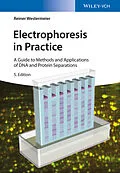This fifth edition of the successful, long-selling classic has been completely revised and expanded, omitting some topics on obsolete DNA electrophoresis, but now with a completely new section on electrophoretic micro-methods and on-the-chip electrophoresis.
The text is geared towards advanced students and professionals and contains extended background sections, protocols and a trouble-shooting section. It is now also backed by a supplementary website providing all the figures for teaching purposes, as well as a selection of animated figures tested in many workshops to explain the underlying principles of the different electrophoretic methods.
Autorentext
Reiner Westermeier worked after PhD graduation and Post-doc at the Technische Universitat Munchen for 30 years as a specialist for electrophoresis methods for leading bioanalytics and biotechnology companies. His area of responsibility included co-operation in product development, writing of scientic papers and method instructions, trouble shooting in customer laboratories, performing seminars and practical courses on electrophoresis and proteomics, as well as giving scientific talks at congresses on a world-wide basis. He is editor and author of several books, e.g. 'Electrophoresis in Practice' (in German and in English), 'Proteomics in Practice', and 'Difference Gel Electrophoresis'.
Inhalt
Foreword XIX
Abbreviations, Symbols, Units XXI
Preface XXV
Part I Fundamentals 1
Introduction 1
Principle 1
Areas of Applications 3
The Sample 3
The Buffer 4
Electroendosmosis 5
References 6
1 Electrophoresis 7
1.1 General 7
1.1.1 Electrophoresis in Free Solution 7
1.1.2 Electrophoresis in Supporting Media 12
1.1.3 Gel Electrophoresis 13
1.1.3.1 Gel Types 13
1.1.3.2 Instrumentation for Gel Electrophoresis 17
1.1.3.3 Current and Voltage Conditions 17
1.1.4 Power Supply 19
1.1.5 Separation Chambers 20
1.1.5.1 Vertical Systems 20
1.1.5.2 Horizontal Systems 21
1.2 Electrophoresis in Nonrestrictive Gels 25
1.2.1 Agarose Gel Electrophoresis 25
1.2.1.1 Zone Electrophoresis 25
1.2.1.2 Immunoelectrophoresis 26
1.2.1.3 Affinity Electrophoresis 27
1.2.2 Polyacrylamide Gel Electrophoresis of Low MolecularWeight Substances 28
1.3 Electrophoresis in Restrictive Gels 28
1.3.1 The Ferguson Plot 28
1.3.2 Agarose Gel Electrophoresis 29
1.3.2.1 Proteins 29
1.3.2.2 Nucleic Acids 29
1.3.3 Pulsed-Field Gel Electrophoresis 30
1.3.4 Polyacrylamide Gel Electrophoresis of Nucleic Acids 32
1.3.4.1 DNA Sequencing 32
1.3.4.2 DNA Typing 34
1.3.4.3 Mutation Detection Methods 35
1.3.4.4 Denaturing PAGE of Microsatellites 37
1.3.4.5 Two-dimensional DNA Electrophoresis 37
1.3.5 Polyacrylamide Gel Electrophoresis of Proteins 37
1.3.5.1 Disc Electrophoresis 37
1.3.5.2 Gradient Gel Electrophoresis 39
1.3.5.3 SDS Electrophoresis 40
1.3.5.4 Cationic Detergent Electrophoresis 47
1.3.5.5 Blue Native Electrophoresis 47
1.3.5.6 Rehydrated Polyacrylamide Gels 48
1.3.5.7 Two-Dimensional Electrophoresis Techniques 49
1.3.5.8 GeLC-MS 50
References 51
2 Isotachophoresis 57
2.1 Migration with the Same Speed 57
2.2 "Ion Train" Separation 59
2.3 Zone Sharpening Effect 59
2.4 Concentration Regulation Effect 59
2.5 Quantitative Analysis 60
References 61
3 Isoelectric Focusing 63
3.1 Principles 63
3.2 Gels for IEF 65
3.2.1 Polyacrylamide Gels 65
3.2.2 Agarose Gels 67
3.3 Temperature 68
3.4 Controlling the pH Gradient 68
3.5 Kinds of pH Gradients 69
3.5.1 Free Carrier Ampholytes 69
3.5.1.1 Electrode Solutions 70
3.5.1.2 Denaturing IEF: Urea IEF 71
3.5.1.3 Separator IEF 72
3.5.1.4 Plateau Phenomenon 73
3.5.1.5 TheWorkflow of a Carrier Ampholyte IEF Run 73
3.5.2 Immobilized pH Gradients (IPG) 73
3.5.2.1 Preparation of Immobilized pH Gradients 75
3.5.2.2 Applications of Immobilized pH Gradients 76
3.6 Protein Detection in IEF Gels 77
3.7 Preparative Isoelectric Focusing 77
3.7.1 Carrier Ampholyte IEF in Gel 77
3.7.2 Carrier Ampholyte IEF in Free Solution 78
3.7.3 Immobilized pH Gradients 78
3.7.3.1 Isoelectric Membranes 78
3.7.3.2 Off-Gel IEF 79
3.8 Titration Curve Analysis 80
References 82
4 High-Resolution Two-Dimensional Electrophoresis 85
4.1 IEF in Immobilized pH Gradient Strips 85
4.1.1 Strip Lengths 86
4.1.2 pH Gradient Types 86
4.1.3 The Influence of Salts and Buffer Ions on the Separation 87
4.1.4 Basic IPG Gradients 88
4.1.5 Advantages of Immobilized pH Gradient Strips in 2D Electrophoresis 89
4.1.6 Rehydration of IPG Strips 90
4.1.6.1 Basic pH Gradients 90
4.1.6.2 Reswelling Tray 91
4.1.6.3 Cover Fluid 91
...